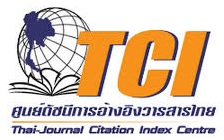Differences in the Test Results of Two Test Rubrics in the Yes/No Vocabulary Test
DOI:
https://doi.org/10.55766/YPZH1827Keywords:
Yes/No Vocabulary Test, Test Rubric, Test Instruction, Vocabulary SizeAbstract
The Yes/No vocabulary test (YN test) is a receptive vocabulary size test that comes in a form of a checklist where learners answer yes to the words they know. However, an inconsistency of the test rubrics has been found. That is, rubric type 1 says: “Write Y (yes) if you know the meaning of the word” while rubric type 2 says: “Write Y (yes) if you think that the word exists in English”. These 2 rubrics seem to require different levels of vocabulary knowledge from test takers. Rubric 1 may need more knowledge of the word meaning while Rubric 2 may need less (i.e. only having seen the word or even guessing). This led to the doubt whether or not the 2 rubrics yield the same YN test results. Therefore, a study was conducted to compare these two rubrics by administering 2 YN test versions, i.e. Rubric 1 YN tests and Rubric 2 YN tests, to 600 first-year students of a university in Nakhon Ratchasima, followed by a translation test as a concurrent validity test. After that, a semi-structured interview of 72 students was conducted in order to gain some insight of how they did the tests. The findings revealed that the results of Rubric 1 YN tests correlated better with the results of the concurrent validity test than those of Rubric 2 YN tests.
References
Anderson, R. C., and Freebody, P. (1983). Reading comprehension and the assessment and acquisition of word knowledge. In B. Huxton (ed.). Advances in Reading/Language Research (pp. 231-256). Greenwich, CT: JAI Press.
Beeckmans, R., Eyckmans, J., Janssens, V., Dufranne, M., and Van de Velde, H. (2001). Examining the Yes/No vocabulary test: some methodological issues in theory and practice. Language Testing. 18: 235-274.
Eyckmans, J. (2004). Measuring Receptive Vocabulary Size. Utrecht: the Netherlands.
Eyckmans, J., Van de Velde, H., Van Hout, R., and Boers, F. (2007). Learners’response behaviour in Yes/No vocabulary tests. In H. Daller, J. Milton and J. Treffers-Daller (eds.). Modelling and Assessing Vocabulary Knowledge (pp. 59-76). Cambridge: Cambridge University Press.
Harrington, M. and Carey, M. (2009). The on-line Yes/No test as a placement tool. System. 37: 614-626.
Laufer, B. (1997). The lexical plight in second language reading: Words you don’t know, words you think you know, and words you can’t guess. In J. Coady and T. Huckin (eds.). Second language vocabulary acquisition (pp. 20-34). Cambridge: Cambridge University Press.
Meara, P. (1990). Some notes on the Eurocentres vocabulary tests. In J. Tommola (ed.). Foreign Language Comprehension and Production (pp. 103-113). Turku: AFinLa
Meara, P. (1991). Vocabulary profiles. In S. Verlinde (Ed.), Proceedings of the Symposium on differentiation in LS Learning and Teaching (pp.7-10). Leuven: Instituut voor Levende Talen.
Meara, P. (1992). EFL Vocabulary Tests. Centre for Applied Language Studies, University of College.
Meara, P. (1996). The dimensions of Lexical Competence. In G. Brown, K. Malmkjaer and J. Williams (eds.). Performance and Competence in Second Language Acquisition (pp. 35-53). Cambridge: Cambridge University Press.
Meara, P., and Buxton, B. (1987). An alternative to multiple choice vocabulary tests. Language Testing. 4: 142-151.
Meara, P., and Jones, G. (1988). Vocabulary size as a placement indicator. In P. Grunwell (ed.). Applied Linguistics in Society (pp. 80-87). London: Centre for Information on Language Teaching and Research.
Meara, P., and Jones, G. (1990). Eurocentres Vocabulary Size Test (version E1.1/K10) [Computer software] Zurich: Eurocentres Learning Service.
Nation, I. S. P. (2001). Learning Vocabulary in Another Language. Cambridge: Cambridge University Press.
Nation, I. S. P. (2004). A study of the most frequent word families in the British National Corpus. In P. Bogaards & B. Laufer (Eds.), Vocabulary in a Second Language: Selection, Acquisition, and Testing (pp. 3-13). Amsterdam: John Benjamins.
Nation, I. S. P., and Hwang, K. (1995). Where would general service vocabulary stop and special purposes vocabulary begin? System. 23: 35-41.
Read, J. (1988). Measuring the vocabulary knowledge of second language learners. RELC-Journal. 19: 12-25.
Read, J. (2000). Assessing Vocabulary. Cambridge: Cambridge University Press.
Read, J. (2007). Second Language Vocabulary Assessment: Current Practices and New Directions. International Journal of English Studies. 7: 105-125.
Saville-Troike, M. (1984). What really matters in second language learning for academic achievement? TESOL Quarterly. 18: 199-219.
Thoma, D. (2011). Strategic attention in language testing: metacognition in a yes/no business English vocabulary test. Frankfurt am Main: Peter Lang.
Ward, J. W. (2005). The lexical aspect of reading English as a foreign language for engineering undergraduates. Ph.D. thesis. The University of Birmingham, U.K.
Downloads
Published
Issue
Section
License
Copyright (c) 2019 Suranaree Journal of Social Science

This work is licensed under a Creative Commons Attribution-NonCommercial-NoDerivatives 4.0 International License.









 ThaiJO
ThaiJO